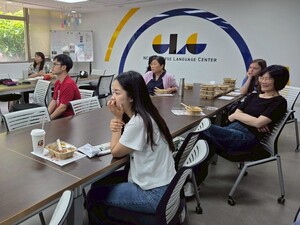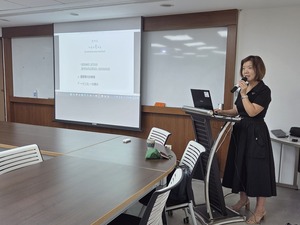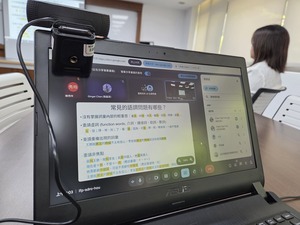Professor Lung-Hua Hu Speaks at NCCU Mandarin Training Center on Effective Tone Instruction and Pronunciation Correction





【Article by Chinese Language Center】
On May 14, 2025, the Chisese Language Center at National Chengchi University hosted a professional lecture as part of its collaboration with the Taiwan Huayu BEST project. The speaker, Professor Lung-Hua Hu, delivered a talk titled “Common Issues in Teaching Mandarin Pronunciation and Effective Correction Techniques.” The lecture focused on practical methods for teaching tones and correcting pronunciation in Mandarin as a second language. It was held in person and also livestreamed for online participants.
Professor Hu recently returned to Taiwan after a distinguished teaching career in the United States. She served from 1999 to 2024 as a faculty member in the Department of East Asian Studies at Brown University. Over the course of more than two decades, she also taught at institutions such as Princeton University, Columbia University, the Middlebury Summer Chinese School, and Duke University’s Beijing summer program. A dedicated educator and leader in the field of Chinese language teaching, she has served as a board member of the Chinese Language Teachers Association (CLTA) and as president of the New England Chinese Language Teachers Association (NECLTA), where she currently remains a board director.
Drawing on her extensive teaching experience abroad, Professor Hu began the lecture by identifying common pronunciation issues faced by Mandarin learners, especially those from non-tonal language backgrounds. These include a consistently low starting point for second tones, clipped fourth tones, and uniform syllable lengths across sentences, all of which contribute to flat, unnatural speech. Professor Hu emphasized that tone instruction should go beyond simple correction; instead, it should integrate visual aids, auditory contrasts, and contextualized practice to help learners develop both accurate and fluent speech.
She introduced several classroom strategies, including the use of musical staff diagrams to visually demonstrate tone contours and the practice of humming tone patterns without consonants or vowels to isolate tonal features. Such methods allow students to focus on pitch movement without being distracted by other phonetic elements. She also noted that even students who can pronounce individual syllables correctly often struggle with tone combinations in sentences, indicating a need for targeted, repetitive practice in tone sequencing.
On the topic of pronunciation correction, Professor Hu stressed the importance of attentive listening and patient, personalized feedback. One particularly effective method she described involves first mimicking the student’s incorrect pronunciation, then immediately demonstrating the correct form, helping the student recognize the difference. She also recommended using audio recording tools and visual pitch analysis to raise learners’ awareness and improve self-monitoring.
Throughout the talk, Professor Hu provided detailed analysis of common phonetic challenges. She addressed the frequent mispronunciation of initials such as j, q, and x, which are often influenced by English approximations like chee or shee. She also discussed issues related to ü and üe, which require precise tongue placement and rounded lips, and final syllables like iu and ui, which are often truncated. Such subtle errors, she explained, often lead to noticeable “foreign accents” and can hinder effective communication if not addressed early and consistently.
A major portion of the lecture was dedicated to the concept of the “half third tone,” a crucial yet frequently misunderstood feature of Mandarin prosody. In natural speech, third tones are often shortened and lowered rather than fully dipped. However, many learners and even instructors fail to teach or apply this properly, resulting in awkward or exaggerated intonation. Professor Hu recommended vocal fry exercises and targeted practice using common lexical items to help students master the subtle pitch and length characteristics of the half third tone.
Throughout the session, Professor Hu illustrated her points with rich examples, including audio clips, transcriptions, and live demonstrations. Her insights, drawn from decades of front-line teaching, were well received by attendees, who appreciated the balance between theory and practice. She concluded the lecture by encouraging teachers to remain attentive and enthusiastic in their instruction, reminding everyone that pronunciation teaching—though demanding—has a lasting impact on students’ confidence and communicative success.
This event was part of the NCCU Mandarin Training Center’s ongoing efforts to support professional development in Mandarin education. Under the support of the Excellent Mandarin Project, the Center will continue to host workshops, lectures, and academic exchanges to strengthen Taiwan’s leadership in high-quality Chinese language instruction.


 Fax:886-2-29379611
Fax:886-2-29379611